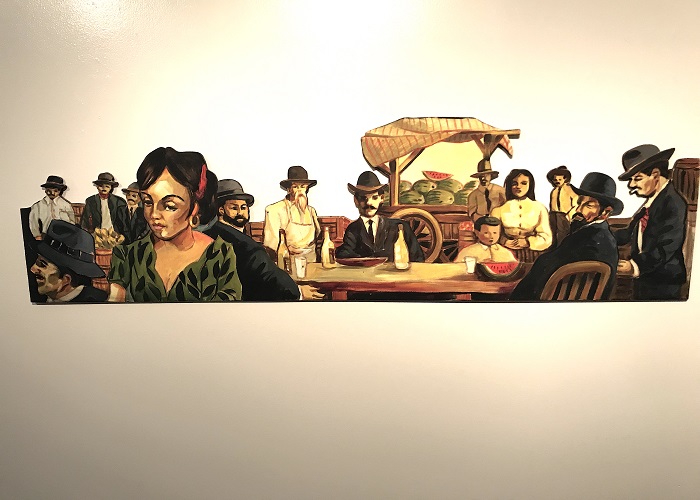Our ancestors once lived in Mexico. On Sundays they gathered at the Main Plaza facing San Fernando Cathedral. They irrigated their farms with San Antonio River water, and drank from San Pedro Springs. Some families carried the family names of Navarro, Flores, Seguin, Ximenes, and Esparaza. They never crossed the border into the United States– the border crossed them.
In those early days a geographic dividing line did not exist between northern Mexico and Texas. Mexican vaqueros thought nothing about crossing their cattle across the Rio Bravo, the Nueces River, the San Antonio, and Guadalupe River. There was nothing special about the Rio Bravo other than the recognition that the river was also called Rio Grande.
People of Mexican origin have lived in the borderland region for generations. My great grandmother, Marta Pompa, is buried in Benavides, Texas. Her headstone notes that she was born in 1834 and died in 1939–at the age of 105. In her lifetime Texans fought at the Alamo and readied for war in Europe to defeat the Nazis. Her son and my grandfather, Jesus Maria Saenz, joined the
cowboys that drove cattle from South Texas along the Chisholm Trail to Kansas.
My grandfather’s parents were part of that generation that saw the American boundaries slowly creeping towards their small ranches in what is now South and West Texas. Some of the new Tejanos had acquired their ranches in 1750 as a result of the great colonizer Jose de Escandon. Escandon brought more settlers to the Tejas borderlands than anyone before him or after–including Stephen F. Austin.
Historian David Weber wrote that by 1755, Escandon “had moved over 6,000 colonists” into the border region and “established twenty-three towns and fifteen missions.” Towns such as Brownsville, Laredo, Del Rio, and Eagle Pass exist today because of the Mexican settlers brought by Escandon.
In an effort to better understand the border area today, two native Texans, Oscar Casares and Joel Salcido, travelled from El Paso to Brownsville on a literary and photographic journey. Their account of what they saw was published in the September 2019 issue of Texas Monthly, which commissioned their investigation.
I feel somewhat qualified to comment on the work of Casares and Salcido having once travelled the same Texas route but extending my trip to include the New Mexico and Arizona border area and ending at the international line on the Pacific Ocean. My wife, Harriett, a sociologist, and our two young children, Anadelia and Carlos, went with me on this border adventure. The trip, which originated in Austin, took us to the Gulf of Mexico and ended at the Pacific Ocean, a distance of over 1800 miles. After a few days in the Tijuana-San Diego region, we returned to our home in Austin, comfortable that we all knew more about the border than the average American. Many of the towns we passed were small and often the roads were desolate. Our return trip of 1300 miles, also along much of the border, made me aware of the expansiveness of areas associated with the U.S.-Mexico border. If I learned anything, it was that I had tried to see too much in a short span of ten days. It was like drinking history and culture from a fire hydrant.
Casares and Salcido’s trip along the Rio Grande from El Paso to Brownsville makes more sense. They wisely began in El Paso, Salcido’s hometown, where he had spent several decades as a journalist with the El Paso
Times. The trip ended in Brownsville, a region where Casares grew up. They travelled a total of 1200 miles.
I met Casares in Austin in the late 1980s. He framed the border issues in this manner for Texas Monthly: “There are two narratives of the border. “One version tells us the border is a lawless land, a region in constant crisis, overrun with crime, unauthorized immigration, asylum camps, kids locked up in cages, drug smuggling, cartel violence, armed militias.”
Casares recognizes that this version of the border contributes to its politicization. When President Trump promotes the building of a wall–a tall barrier to keep Mexican and Central Americans from entering the United States, he is expressing his frustration with the “bad” border.
But there is a second version of the border, one that Casares prefers. In this narrative, he focuses on the everyday life on the border: “a region that’s home to parents and tios and abuelas, of comadres and primos, of people raising their families, of people enduring, of people falling in and out of love, of people dreaming their own dreams.”
Casares, as noted earlier, grew up in Brownsville and he titled his first novel “Brownsville,” in which he included stories about people and events in his hometown. More recently Casares completed his latest novel “Where We Come From.” (2019) In this novel, Casares writes about a retired school teacher who inadvertently becomes part of a human-trafficking operation. When her godson appears from Houston, drama and danger are added to their lives. Casares told the Brownsville Herald that it is also a story about what happens when “you move away…and find yourself navigating a larger world that you may not be prepared for.”
Casares left Brownsville in the 1980s to attend the University of Texas at Austin and now teaches in the UT Austin Creative Writing Program.
Trinity University Press, in their promotion of Joel Salcido’s first book, “The Spirit of Tequila,” noted that Salcido “grew up in Mexico and the United States, straddling two languages and two cultures.”
Salcido’s assignment in the Texas Monthly border journey was to capture the visual border, and his photos are truly majestic. I especially like the photo of Carlos Ramirez walking down a street
in El Paso’s El Segundo Barrio, which Salcido calls “the other Ellis Island.” Salcido grew up in that barrio which was made famous by journalists who stood on the rooftops of homes in El Paso to record the beginning of the Mexican Revolution across the river in Juarez in 1911.
Border stories date back to the founding of the Republic of Texas when the boundary divisions between Texas and Mexico were first created. While older stories have been lost, scholars such as Americo Paredes and Jovita Gonzales left us excellent accounts of life in the borderlands in the early days. Ramon Saldivar’s “The Borderland of Culture: Americo Paredes and the Transnational Imaginary,” also contributes to an understanding of that earlier era.
In the mid 1990s, Saldivar interviewed Don Americo Paredes, a fellow native of Brownsville. Dr. Paredes taught as a distinguished professor of English and Folklore at the University of Texas for forty years. Saldivar’s narrative captures the essence of understanding early border culture. Professor Paredes, speaking about his published works, said: “I was being an advocate for my
people. Enough had been said about them negatively that I wanted to point to the exception, the remarkable ways in which their communities held together under great external pressure from discrimination and other social injustices.”
Another academic work, Gloria Anzaldua’s groundbreaking book, “Borderlands/La Frontera: The New Mestiza,” published in the late 1980s, stands as one of the major studies of border culture and identity. Anzaldua wrote in her preface: “I am a border woman. I grew up between two cultures, the Mexican (with a heavy Indian influence) and the Anglo (as a member of a colonized people in our own territory). I have been straddling that tejas-Mexican border, and others, all my life. It’s not a comfortable territory to live in, this place of contradictions. Hatred, anger and exploitation are the prominent features of this landscape.”
Teresa Palomo Acosta wrote that Anzaldua has “drawn critical praise for her book’s incisive exploration of the United States-Mexico border region, which she has compared to ‘un herida
abierta’ (an open wound) where the Third World grates against the first and bleeds.”
Acosta, in her book, “Las Tejanas: 300 Years of History,” offers an excellent summary of Anzaldua’s literary contribution. In “Borderlands,” Acosta writes, Anzaldua also explores the issues that “all Chicanas traverse, including spiritual and political boundaries.”
Scholarly interest on border issues predates the last century. Americo Paredes and others, however, first introduced border folklore and literature to college curriculum during the 1960s, and this academic field has expanded significantly over the years.
The border initially emerged as a subject for Mexican American scholars challenging stereotypes and misconceptions about the borderlands people and the region. Today, the U.S.-Mexico border has become politicized and has emerged as one of the most discussed national topics of this decade.
The September 2019 tragic events in El Paso where 22 people were massacred by a murderer
professing hatred for immigrants and Brown people is a result of too much hate speech in the national arena. However, we can remain hopeful that the analytical observations and academic studies mentioned in this essay gives us a greater understanding of the borderlands region where cultures meet and interact in complex ways and change over time as people cross borders, raise families, and record their own narratives.







